Last Updated: July 9, 2024
Absolutely, Nikko, Japan is Worth Visiting! I was here for a day in May 2023 and was amazed by its unique attractions, such as Toshogu Shrine that includes Tokugawa Ieyasu’s mausoleum. He was Japan’s first shogun (ruler) of the Edo period.
I also wandered along the mysterious Kanman walking path that leads to Kanmangafuchi Abyss. It’s famous for the row of 74 Jizo statues and Reihikaku Pavilion. Lastly, I had to see the sacred red Shinkyo Bridge and try Yuba, a soy bean curd skin specialty dish from this region.
Nikko is a small city in the mountains of the Tochigi Prefecture in eastern Japan. The Buddhist monk Shodo Shonin founded this city more than 1,200 years ago. Want to learn more about what makes this city special? Then keep on reading and you’ll find out if Nikko, Japan is Worth Visiting!
Disclosure: I only recommend products that I’ve used in the past, and all opinions expressed in this post are my own. This post contains affiliate links. If you use one of the links throughout the page to buy something, I may earn a small commission at no extra cost to you. Thank you!
Things to See and Do in Nikko
Visit the Amazing Toshogu Shrine
Address: 2301 Sannai, Nikko, Tochigi 321-1431, Japan
Toshogu Shrine is a UNESCO World Heritage Site and was established in 1617. It sits inside a beautiful forest area and more than a dozen buildings make up the shrine complex.
Some have golden leaf ornaments and gorgeous wood carvings, which you cannot find anywhere else in Japan.
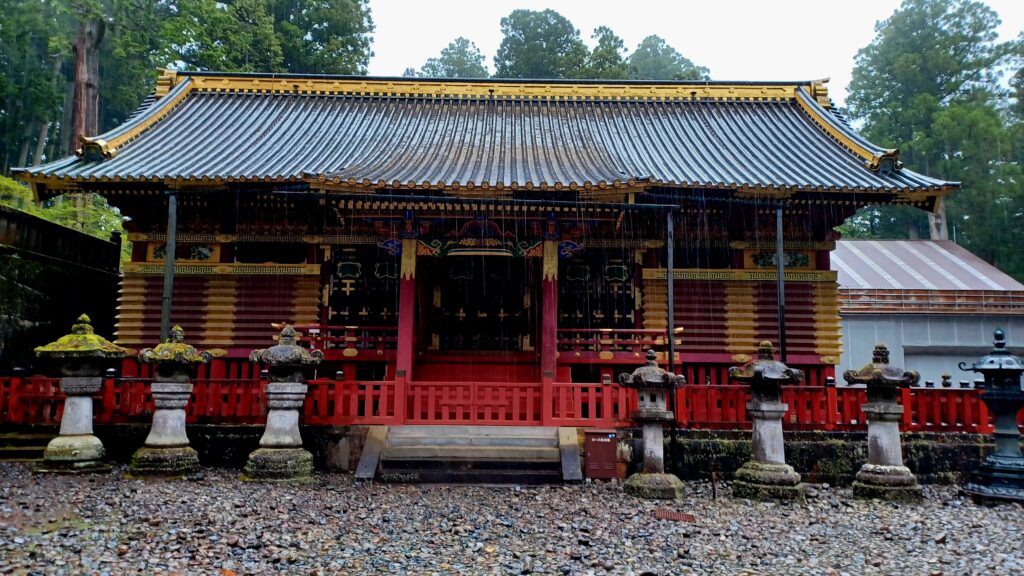
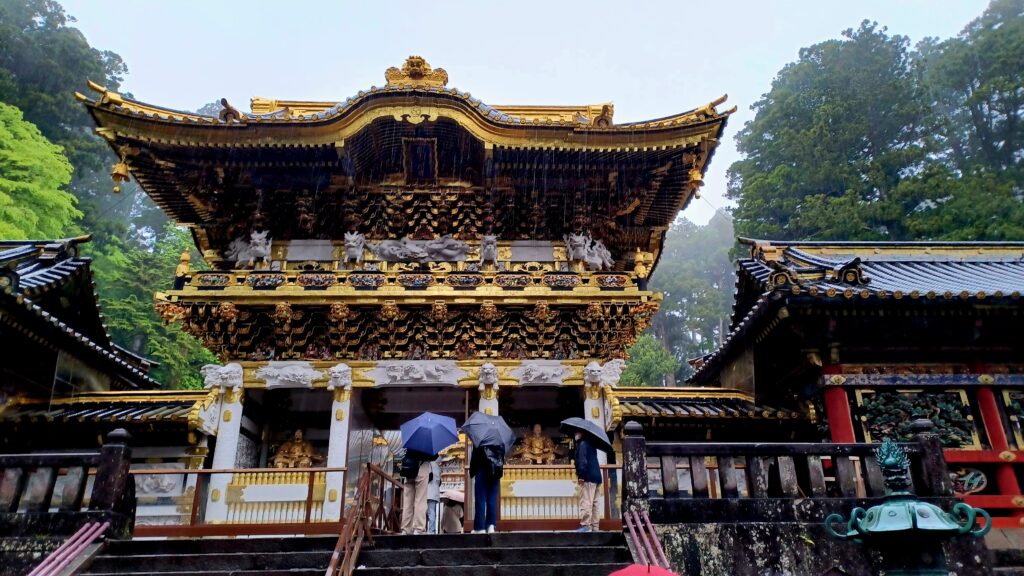
Two buildings with golden leaf decorations inside the Toshogu Shrine complex.
One building that stands out is the Five-Story Pagoda by the main entrance gate of Toshogu Shrine. The main pillar of the pagoda was put 10 cm (3.9 inches) off the ground to avoid that the wood lengthens and shrinks with time.
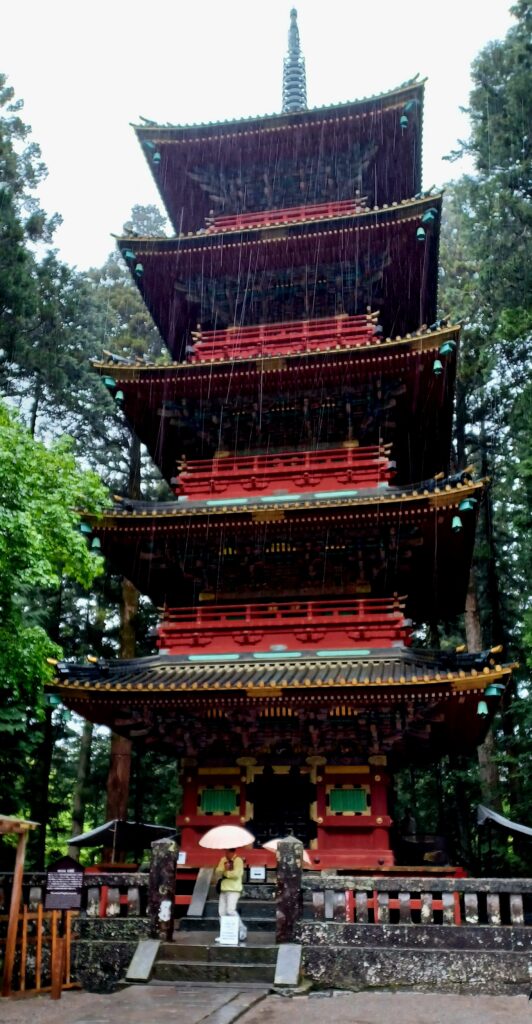
The Five-Story Pagoda close to the entrance of Toshogu Shrine.
Next, check out the colourful animal wood carvings on the storehouses in the entrance area! The most famous ones are the Three Wise Monkeys who “see, hear, and speak no evil” and the Sozonozo Elephants (“imagined elephants”).
People came up with this name because the artist who carved them had never seen a real elephant in his life!
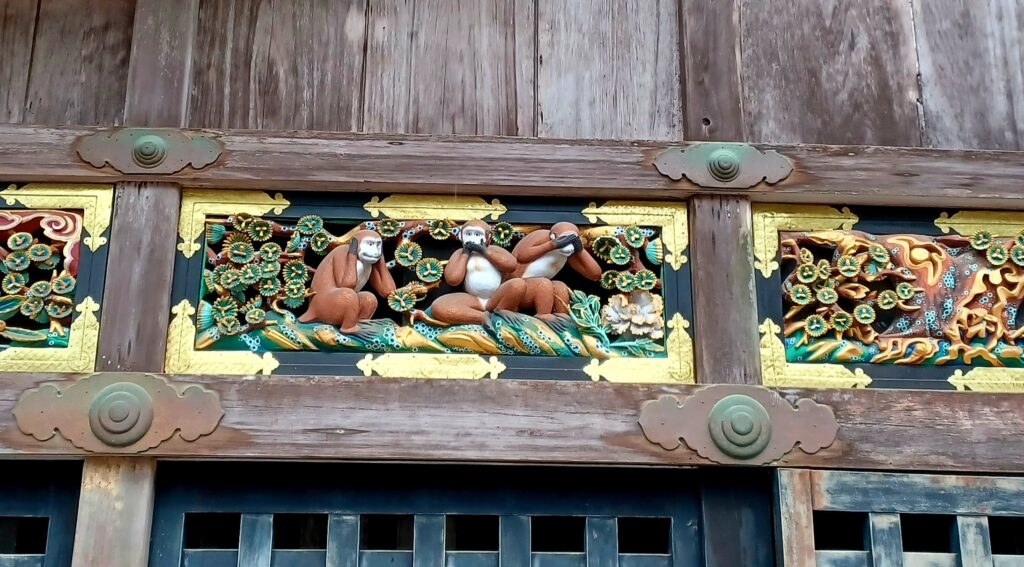
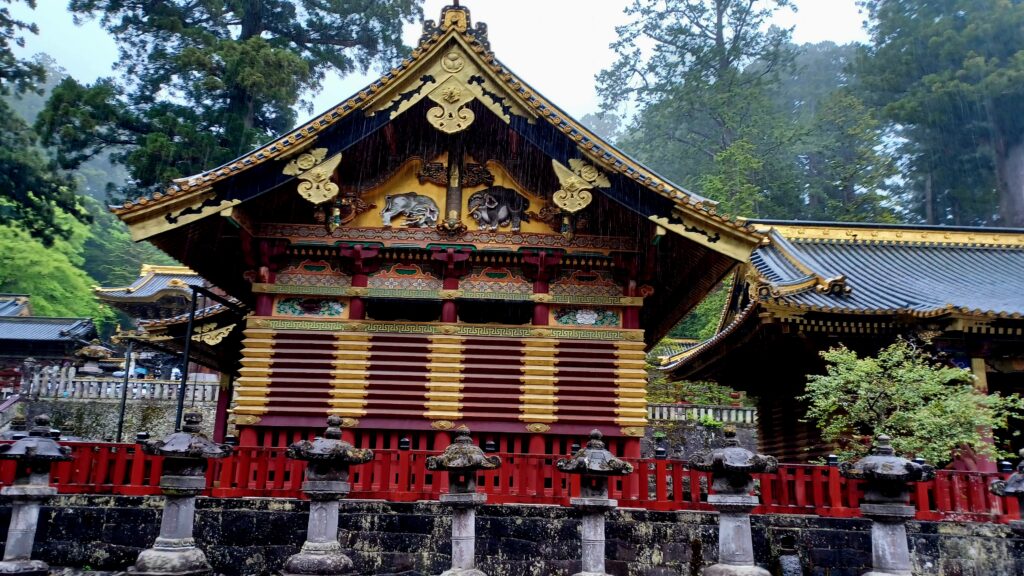
Then enter the Main Shrine Building that has a prayer hall and main hall. They were built to honour the spirits of Tokugawa Ieyasu, Toyotomi Hideyoshi and Minamoto Yoritomo (two other important Japanese historical figures).
Please note that taking photos inside the building is not allowed.
As you walk through the Sakashitamon Gate, look out for the small but iconic Nemurineko (sleeping cat) carving! It’s supposed to guard the entrance gate to Tokugawa Ieyasu’s grave.
On the other side, there are two flying sparrow carvings. They are a symbol for the harmony of all beings in Japan during the peaceful Edo period (1603-1868) after decades of civil wars.
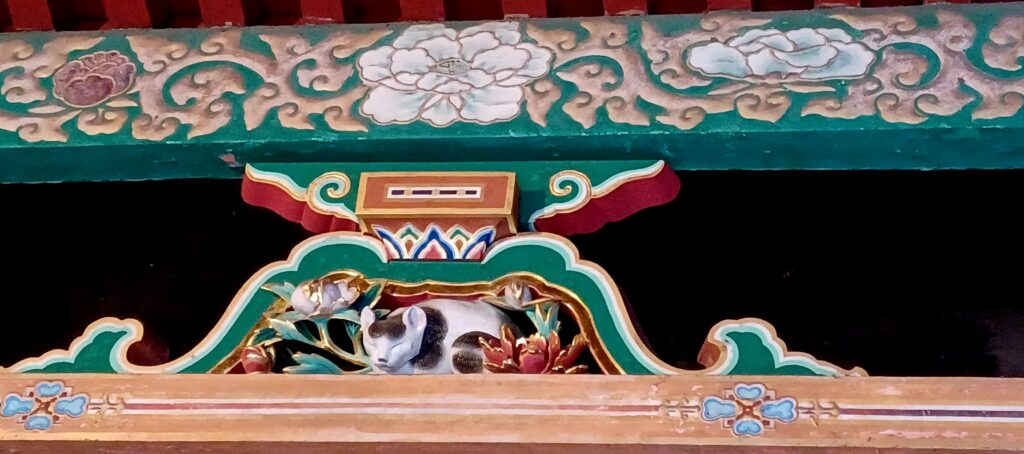
Now we’ve reached Tokugawa Ieyasu’s (1543-1616) final resting spot! Ieyasu is enshrined as the deity Tosho Daigongen, which means “Great Deity of the East Shining Light”.
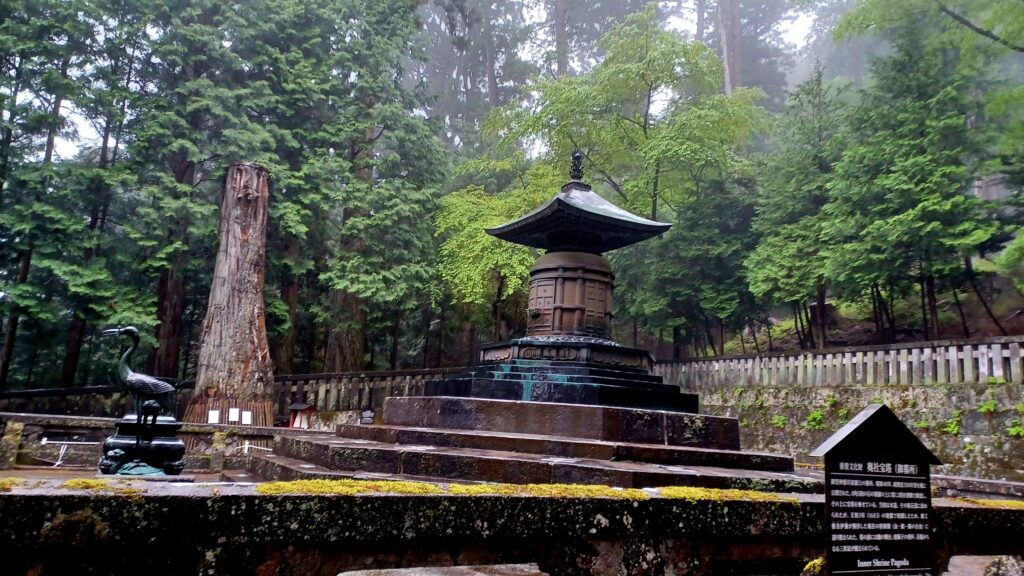
Normally, Buddhist temples and Shinto shrines in Japan are separate entities. But Toshogu Shrine has elements of both religions, as they were blended together until the Meiji period (1868-1912) began.
While Buddhist elements were removed from many shrines soon after, this didn’t happen here.
Lastly, you can visit the Nikko Toshogu Museum. It opened in 2015 to commemorate the 400-year anniversary of Tokugawa Ieyasu’s death. It displays his armor and swords, but also writing tools and letters he wrote.
Toshogu Shrine is open daily from 9 am to 5 pm (4 pm from November to March).
Admission is ¥ 1,300 for the shrine, ¥ 1,000 for the museum only, and ¥ 2,100 for the shrine and museum.
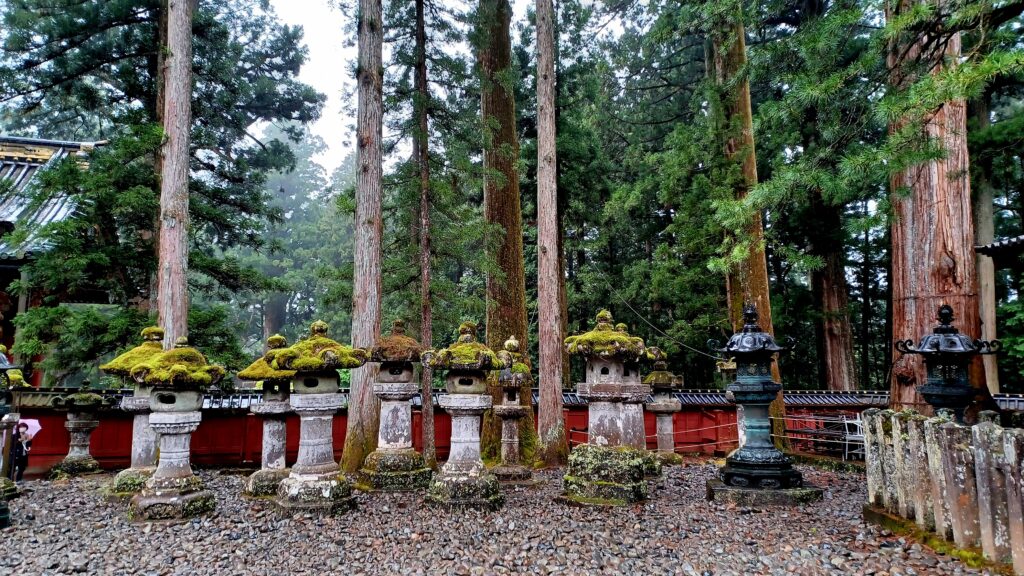
Wander along the Kanmangafuchi Abyss
Address: Takumicho, Nikko, Tochigi 321-1415, Japan
The gorgeous 5-km (3.1-mile) Kanman walking path in the less touristy west side of Nikko leads to the Kanmangafuchi Abyss. It’s a volcanic canyon within a peaceful forest along the Daiya River. The riverbanks were created by lava flows when nearby Mount Nantai erupted a long time ago.
One of the highlights along the path is Jiun-ji Temple, which Kokai, a high rank Buddhist priest, founded in 1654. Sadly, the great flood of 1902 destroyed the temple, but it was replaced by only one small main hall Hondo in 1973.
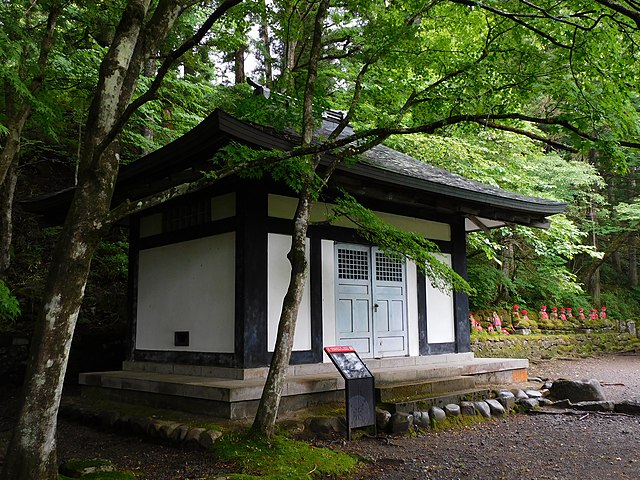
Right next to Jiun-ji Temple you cannot miss the row of 74 Jizo statues facing the Daiya River. These mysterious stone statues wearing red hats and red bibs are guardian deities of travelers and deceased children in Japanese Buddhism.
Initially, one hundred Jizo statues sat here, but because of the river’s vagaries, some have vanished with time. In fact, I read that every time people visit this spot, the number of Jizo statues is different. That’s why they are also called bakejizo (phantom Jizo).
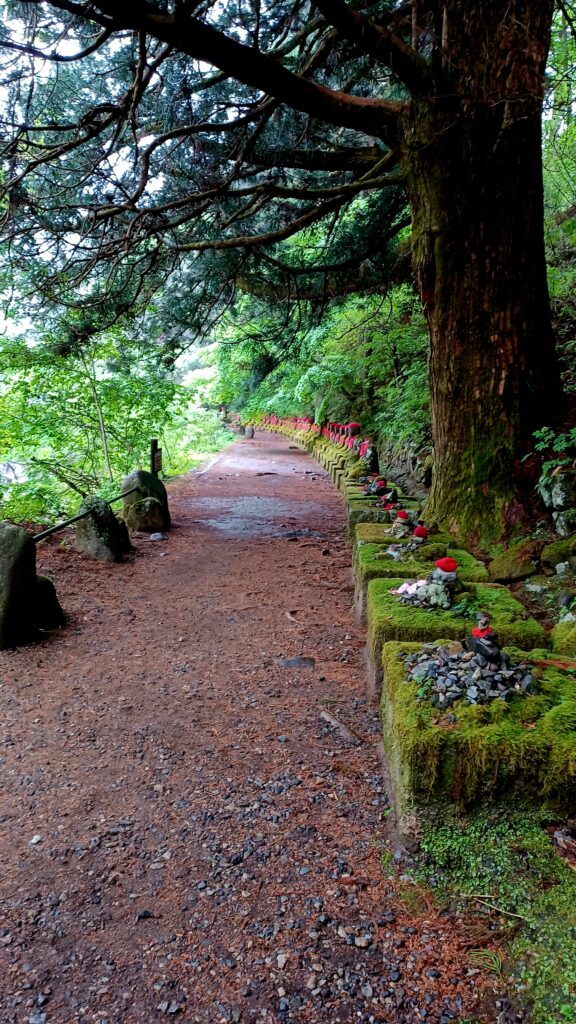
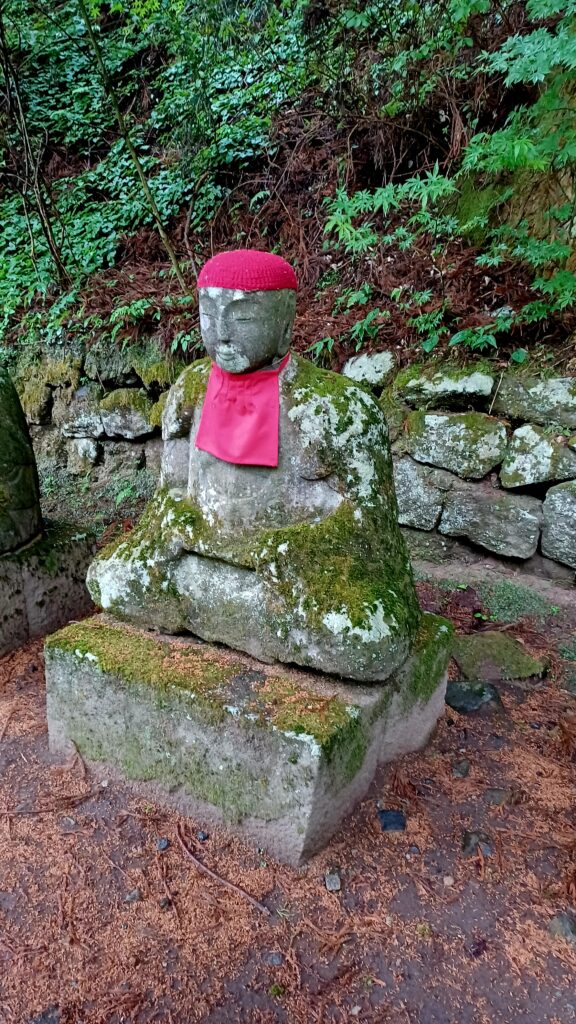
The row of Jizo statues and one single Jizo statue.
Another scenic spot, only a few steps further, is Reihikaku Pavilion. The original building had a stone altar that was used to do the Goma Fire ritual. Its main characteristic was burning pieces of paper or wood with prayers written on them.
This way, Fudo Myoo, one of the Five Wisdom Kings in Buddhism, could hear the prayers.
Unfortunately, the great flood of 1902 ruined Reihikaku Pavilion and a statue of Fudo Myoo as well. The pavilion we can look at today was completed in 1971.
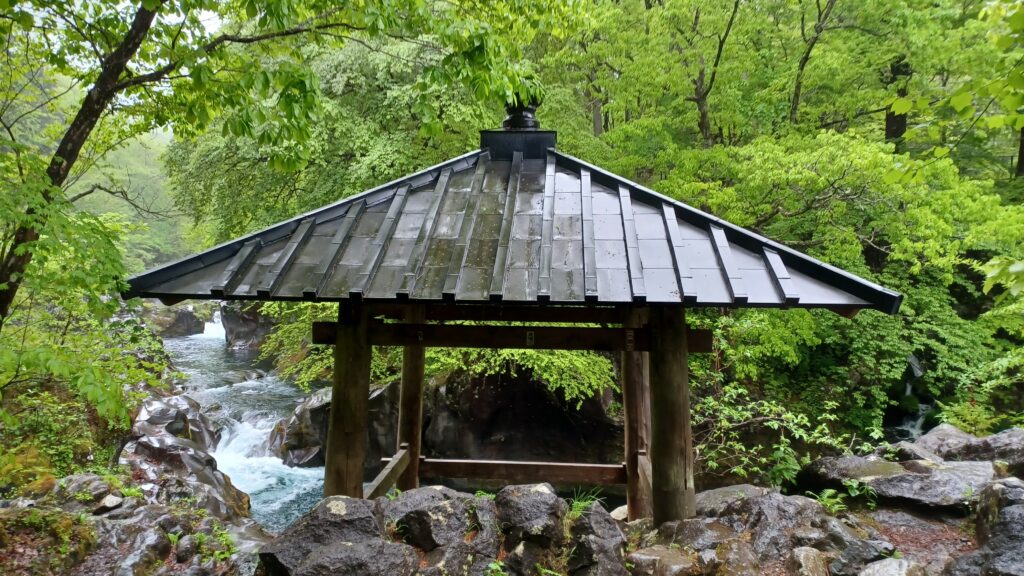
The path to Kanmangafuchi Abyss is always open and there’s no admission fee.
While the Daiya River looks gorgeous, visitors are advised to stay away from its banks, because they are very slippery.
Sadly, I didn’t walk all the way to the Kanmangafuchi Abyss. But I loved that the path wasn’t as busy as other places in Nikko (only three people passed me on the way). The green and peaceful forest area made me feel so calm, that I almost forgot I was in a city!
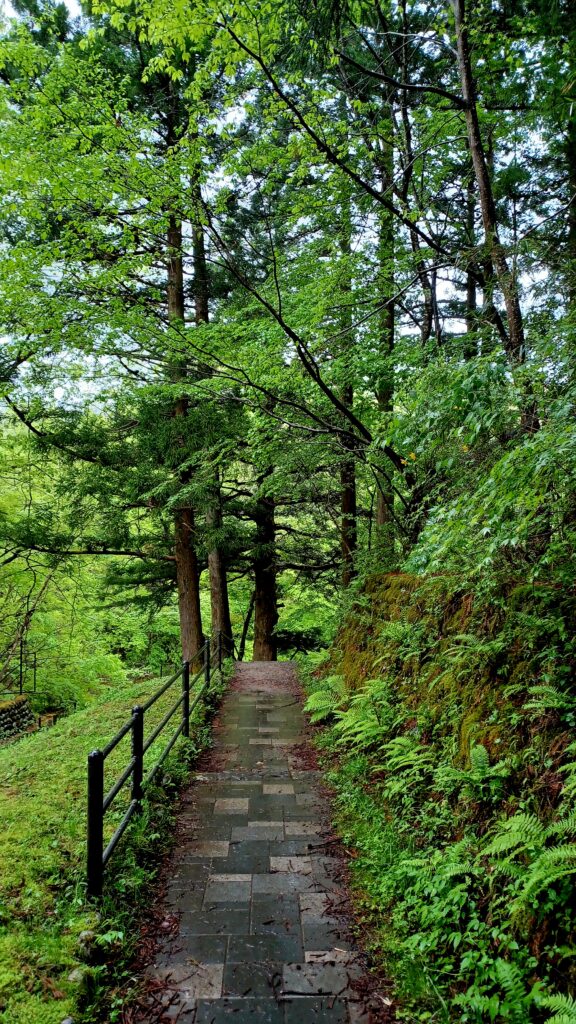
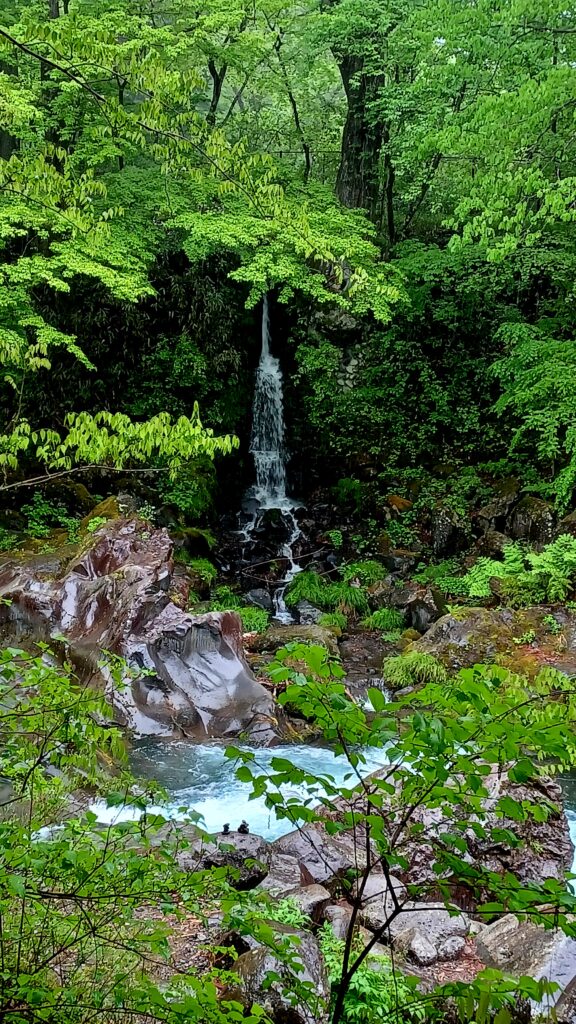
The walking path and a beautiful waterfall on the other side of the Daiya River!
Admire the Sacred Shinkyo Bridge
Address: Kamihatsuishimachi, Nikko, Tochigi 321-1401, Japan
The bright red Shinkyo Bridge (“sacred bridge”) across the Daiya River in the city centre marks the entrance to Nikko’s shrines and temples.
It was completed in 1636, but there was a bridge at the same spot long before that. The great flood in 1902 destroyed it, too, but it was quickly rebuilt in 1904.
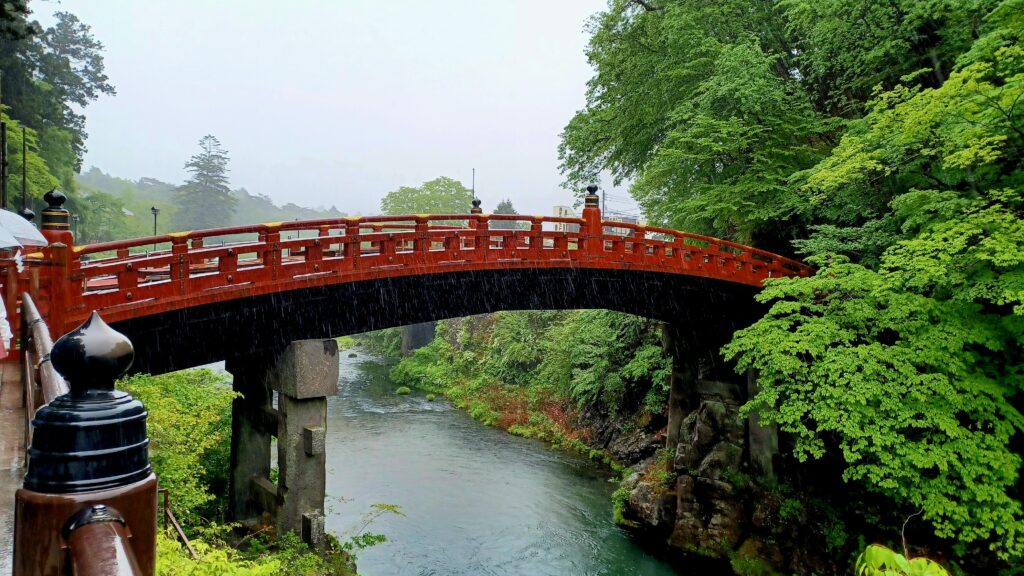
According to legend, in 766 AD, the priest Shodo Shonin and his followers couldn’t cross the Daiya River, because there was no bridge. But after Shodo said a prayer, the god Jinja-Daisho showed up on the other side with two big snakes wrapped around his arm.
Then the god threw the snakes across the river and they turned into a rainbow-coloured bridge.
Until 1973, crossing the Shinkyo Bridge was limited to important military leaders and imperial messengers. But nowadays, everyone is allowed to enter the bridge after paying a small admission fee of ¥300.
The Shinkyo Bridge is open daily from 8:30 am to 4 pm (April to October) and 9:30 am to 3 pm (November to March).
Other Things to See and Do in Nikko
Unfortunately, one day wasn’t enough to see everything that the Nikko region has to offer.
So here are few other places that I think, make Nikko, Japan, worth visiting as well:
Rinnoji Temple
Address: 2300 Sannai, Nikko, Tochigi 321-1431, Japan
Rinnoji Temple is the oldest and most important temple in Nikko. It was founded by the monk Shodo Shonin in the 8th century. He devoted it to the Nikko area’s three sacred mountains (Mt. Nantai, Mt. Taro, and Mt. Nyoho).
The mountains are represented by three gold lacquered wooden statues of an amida buddha and two cannon bodhisattva in the main hall. The latter is a person who’s on the path to reaching Nirvana in Buddhism.
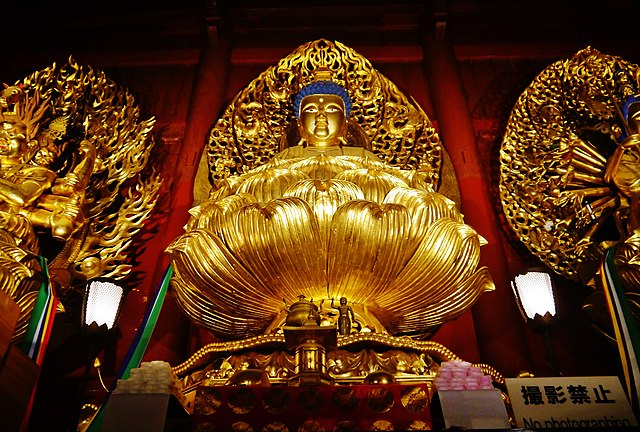
Rinnoji Temple is open daily from 8 am to 5 pm (4 pm from November through March).
Admission starts at ¥400 per person.
Kegon Waterfalls
Address: 2479-2 Chugushi, Nikko, Tochigi 321-1661, Japan
Kegon Waterfalls (97 m/318 ft tall) is in the Okunikko region within Nikko National Park. They are one of Japan’s Top 3 Waterfalls. You can watch them from a free observation deck, a paid platform with three decks, or Akechidaira Observation Deck.
Kegon Waterfalls freeze solid sometimes during the winter months and the scenic Lake Chuzenji is right behind them.
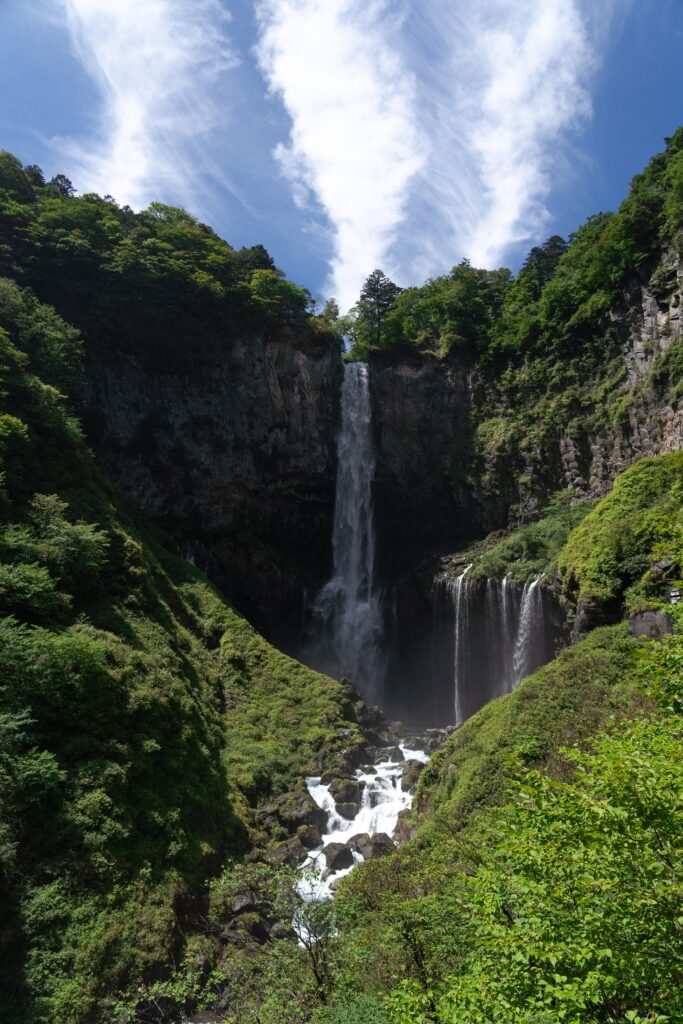
Senjogahara Hiking Trail
Address: Chugushi, Nikko, Tochigi 321-1661, Japan
Senjogahara Hiking Trail is 6 km (3.7 miles) long and goes from the Ryuzu Waterfall to the town of Yumoto Onsen through the Senjogahara Marshlands. All hiking levels are welcome! In winter, the trail is accessible with snow shoes or cross-country skis, which you can rent in the area.
Where to Stay in Nikko
I booked a private room at the Turtle Inn (2-16 Takumi-cho, Nikko, Tochigi, 321-1433, Japan), a simple, but clean and affordable Japanese guesthouse. It’s in a quiet residential area and a bus stop to the city centre is nearby.
The private indoor onsen was perfect to recover from walking around Tokyo a lot!
The kind receptionists made me feel at home right away and the Turtle Inn is only steps from the Daiya River. So when I laid down at night, all I could hear was the calming rushing of the water! The healthy breakfast was very yummy, too.

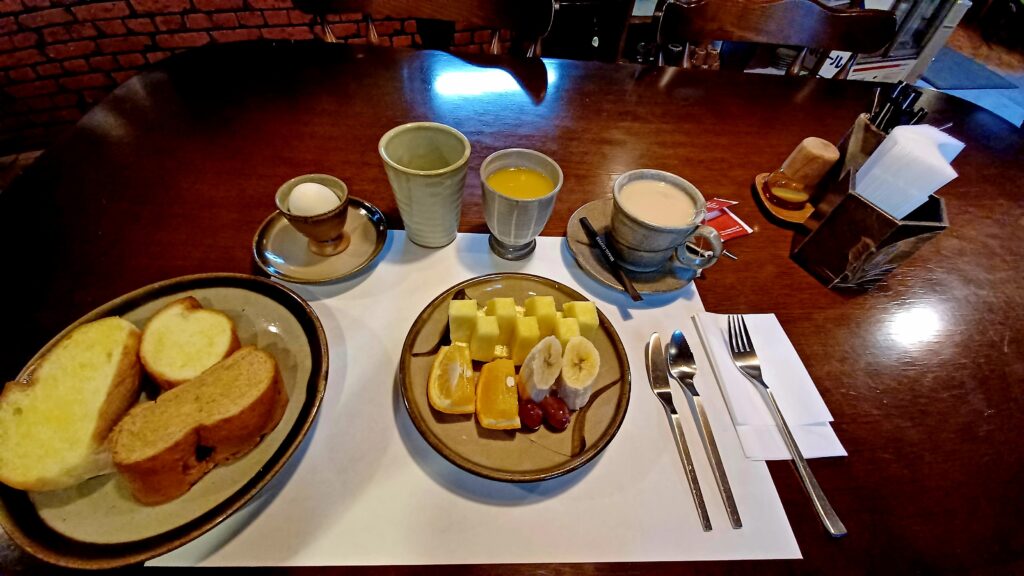
Where to Eat & Drink in Nikko
The Bell Café
Address: 6-39 Yasukawacho, Nikko, Tochigi, 321-1432, Japan
The Bell Café is a small but cozy café/restaurant in the Nikko city centre. I tried the “Yuba Festa” (Monk’s diet), a set meal featuring yuba (soy bean curd skin), shiitake mushrooms, veggie tempura, miso soup, and yuba sashimi!
Yuba is a specialty dish from the Nikko area. Besides, this is one of the few places in town where you can try a vegetarian version.
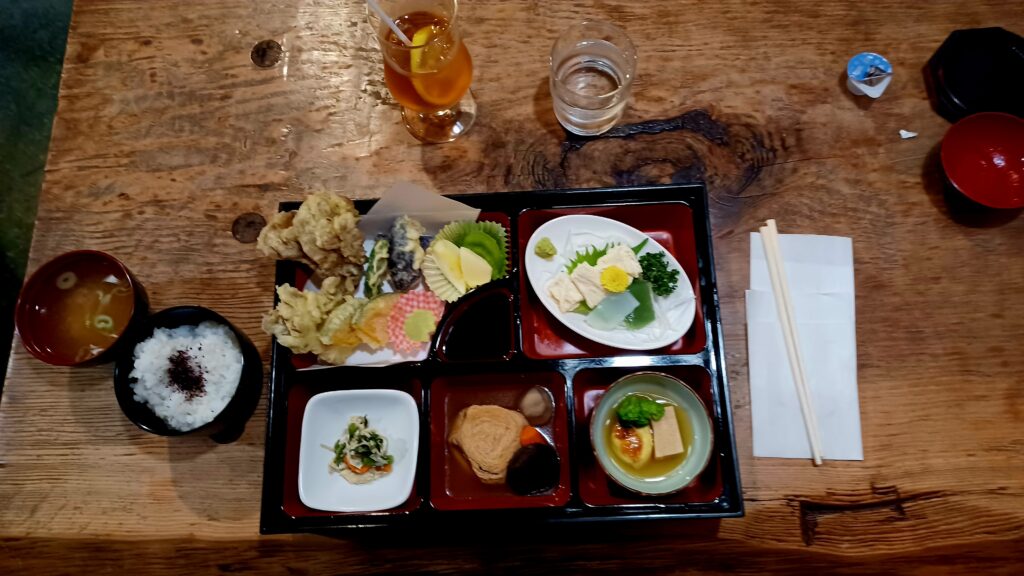
The Bell Café is open daily from 10:30 am to 4 pm and 6 pm to 9:30 pm. The service was great as well! When I visited in May 2023, they only accepted cash, no credit or debit cards.
Sogen Coffeeshop
Address: 1-21 Yasukawacho, Nikko, Tochigi 321-1432, Japan
Sogen Coffeeshop is a cozy spot for a break after walking around town! The elderly couple who manages the place went above and beyond to make me feel comfortable. For example, the man brought me a portable heater after he’d seen that my clothes were soaked from the rain!
I ordered ocha (Japanese Green Tea) with biscuits, which was very good! Their little gift shop is perfect for finding a homemade bringalong! As of July 2024, Sogen Coffeeshop is open every day (except Thursdays) from 9 am to 5 pm.
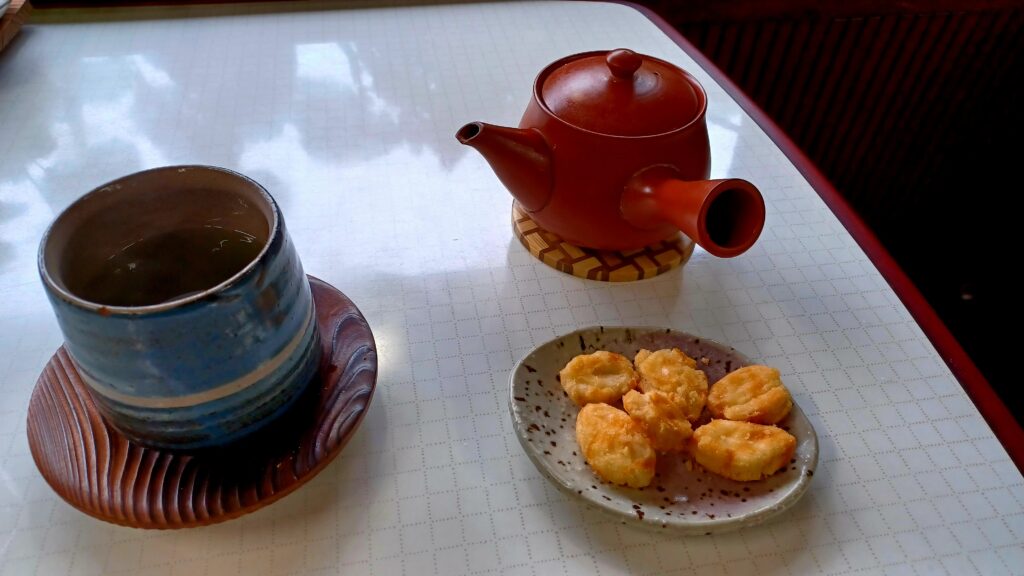
How Many Days Should I Spend in Nikko?
Nikko is a popular spot for international and local tourists. Some go here for just a day trip, but I recommend staying in Nikko for two days. That way, you’re not in a rush.
You’ll have time to visit Toshogu Shrine, Rinnoji Temple, Shinkyo Bridge, Kanmangafuchi Abyss, and find a few cool souvenirs on your first day.
On Day Two, you could take a bus to the Nikko National Park area to see Kegon Waterfalls and Lake Chuzenji, and go for a hike.
When is the Best Time to Visit Nikko?
Many people visit Nikko in October and November, so they can enjoy the pretty fall foliage (koyo)! The best spots in town to see them is by the Shinkyo Bridge and on the trail leading to the Kanmangafuchi Abyss. You can also see them inside Nikko National Park.
Nikko is a bit cooler than other places in Japan during the summer months (May to September) thanks to its location in the mountains.
December and January are the coldest months in Nikko, with occasional snowfall and temperatures falling down to -4 C (24.8 F)! Besides, some sites and restaurants in the Okunikko area are closed during the winter season.
In the spring, same as other places in Japan, people come here to admire the gorgeous cherry blossoms.
Please keep in mind that August and September is typhoon season in Japan.
How to Get to and Around Nikko on Public Transit
Nikko is about 100 km (62 miles) north of Tokyo and train journeys take 90 to 120 minutes.
I bought the Nikko Pass World Heritage Area at the Tobu Tourist Information Centre inside Asakusa Station in Tokyo (¥ 2,040). It includes a trip to Tobu Nikko Station and back to Asakusa Station for 1-2 consecutive days, as well as a free local bus pass in Nikko.
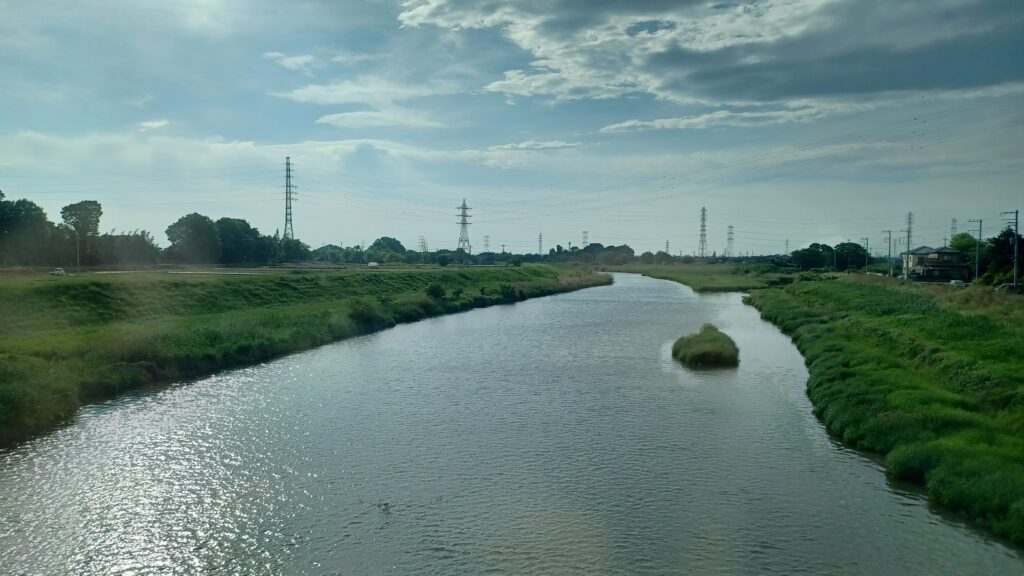
If you’re in Nikko for up to four days, look at the Nikko Pass All Area. It also includes transportation to Lake Chuzenji and the Okunikko region. It’s ¥ 4,600 from April to November and ¥ 4,230 from December to March. These passes are only available to international travelers though.
Or if you have the Japan Rail Pass, take the Tohoku Shinkansen from Tokyo Station to JR Nikko Station (via Utsunomiya). JR East train passes work as well. The two train stations in Nikko are only a short walk away from each other.
There are also Highway buses from Tokyo Narita Airport, Tokyo Haneda Airport, and Yokohama to Nikko.
Visitors who are short on time can take the World Heritage Sightseeing Bus that goes in a circle around some of Nikko’s beautiful shrines and temples. These buses run often from JR Nikko Station and Tobu Nikko Station.
If you’re going to Nikko National Park, note that buses from/to Nikko don’t run very frequently. So check the schedule beforehand to avoid getting stuck somewhere!
Tokyo Narita Airport and Tokyo Haneda Airport are about three hours from Nikko.
Conclusion: Is Nikko, Japan Worth Visiting?
Yes, Nikko, Japan is Worth Visiting for sure! Whether you’re into learning about Japan’s history, relaxing at the many onsens in the region, hiking, watching lakes and waterfalls, or trying local food, there’s something for everyone!
It’s also a perfect spot to escape the busy city life (e.g. Tokyo) for a few days and enjoy some time in nature!
Since I didn’t have time to visit Nikko National Park this time, I can’t wait to go back to Nikko someday!
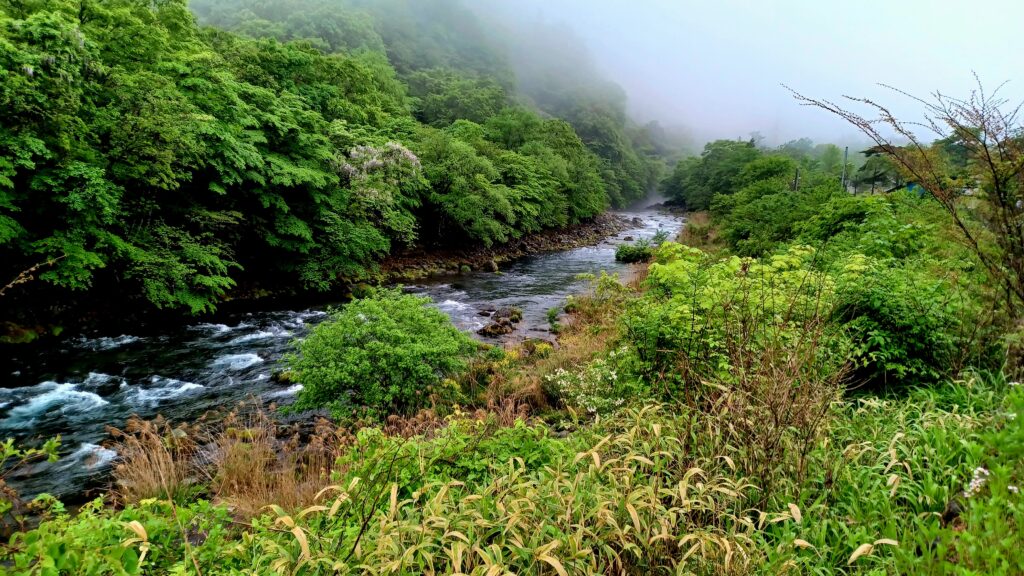
Looking to visit more cool places in Japan?
Then check out these posts:
How to Spend Four Days in Tokyo, Japan
Fukuchiin Temple Stay in Mount Koya, Japan
Is Nagoya Castle Worth Visiting? (Guest Post for The Directionally Challenged Traveler)
How to Spend 48 Hours in Kyoto, Japan
- 9 REASONS TO VISIT LEIPZIG, GERMANY FOR A DAY - April 7, 2025
- ONE DAY IN ANCONA, ITALY: THE 6 BEST THINGS TO DO IN 2025 - February 28, 2025
- THE ULTIMATE SOUTH COAST OF ICELANDITINERARY: THE PERFECT DAY TRIP FROM REYKJAVIK - February 1, 2025

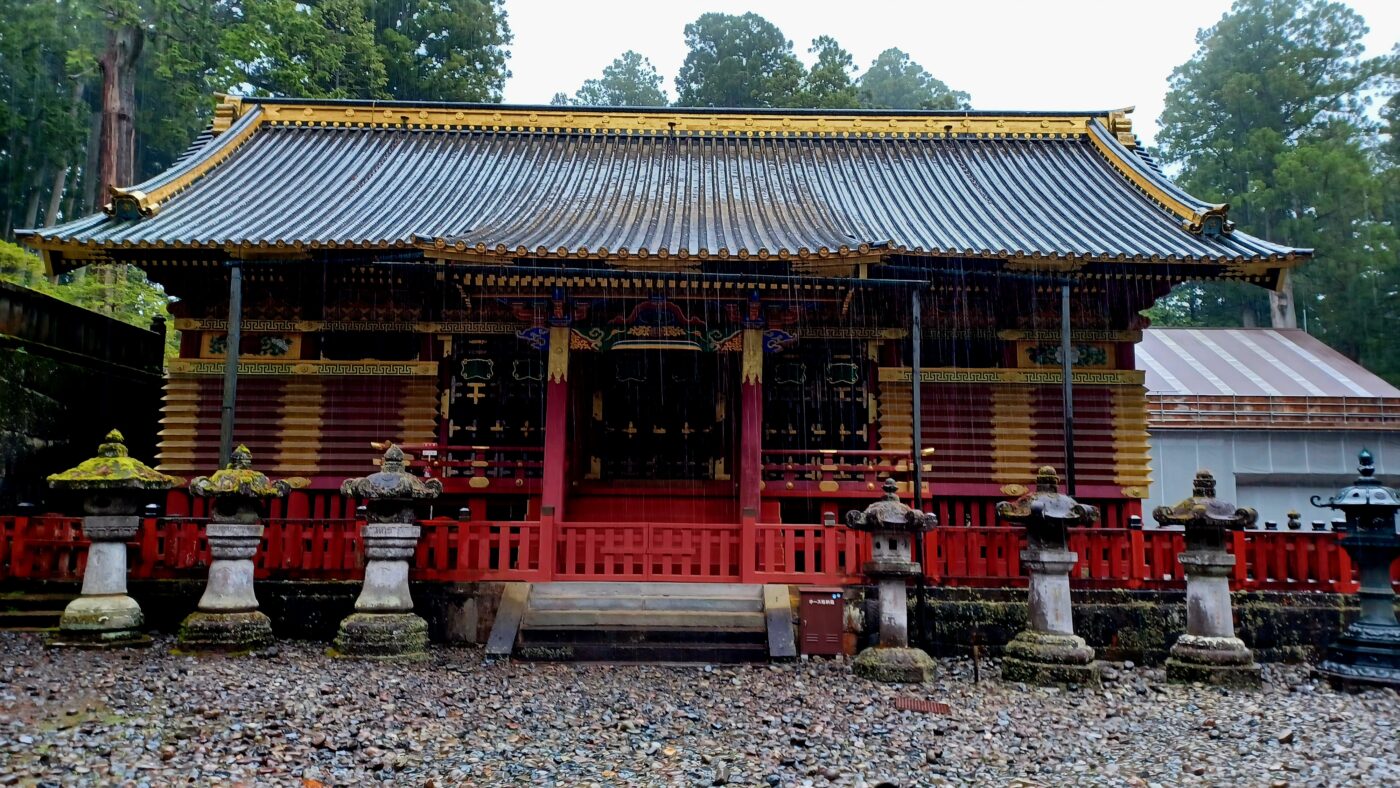
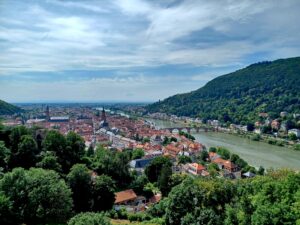
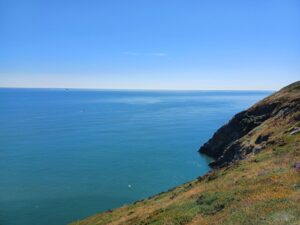
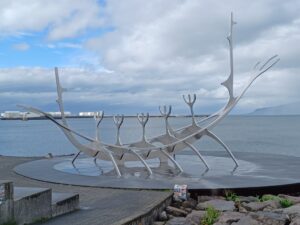
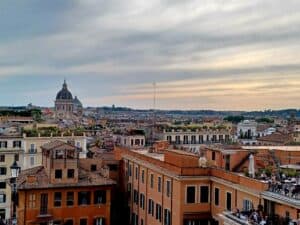
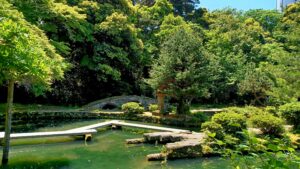
Wow, I didn’t know much about Nikko (or anything for that matter haha) but it’s absolutely beautiful! And I mean, seeing Tokugawa Ieyasu’s tomb and visiting the museum is worth a visit alone, but the scenery is the cherry on top!
Hi Kay! Yes, Nikko is amazing, I highly recommend visiting it for a day or two! It’s not as busy as Tokyo or other cities, but has lots of unique attractions to offer. Toshogu Shrine and the path to Kanmanfuchi Gorge were my favourites!